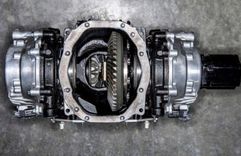

A limited slip differential is a very critical part of a car with a high power output, but to understand it better, it is key to understand the role of a differential first. A differential is a special gearbox designed so that the torque fed into it is split and delivered to two outputs that can turn at different speeds. Differentials within axles are designed to split torque evenly; however, when used between the front and rear axles in four-wheel-drive systems (a center differential), they can be designed to apportion torque unevenly.
A limited slip differential is a differential fitted with a mechanism that limits the speed and torque differences between its two outputs. Limited slip ensures that some torque is always distributed to both wheels, even when one is on very slippery pavement. This pays huge dividends when the road surface is unpredictable or not optimal for driving. A limited slip differential is primary objective, then, is to provide added grip to a car when there is either too much power being sent to the wheels, or if poor road conditions demand it.
The first time a limited slip differential was used was way back in 1935 when the legendary Ferdinand Porsche commissioned the engineering firm ZF to design one. It was deemed necessary because he had designed a high-power Grand Prix racing car whose rear wheels experienced excessive wheel spin.